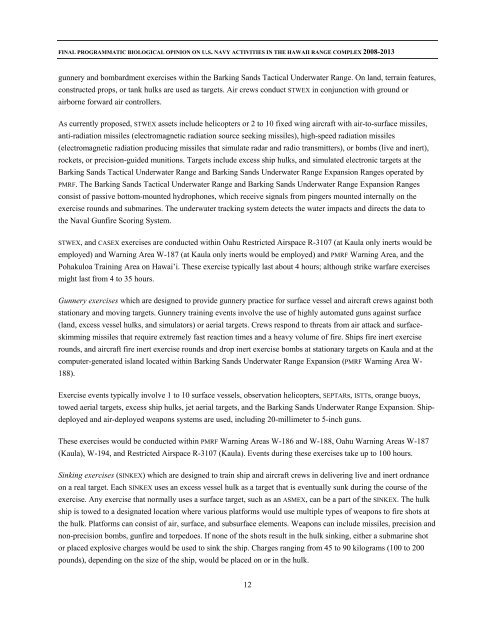NMFS Biological Opinion on U.S. Navy training ... - Govsupport.us
NMFS Biological Opinion on U.S. Navy training ... - Govsupport.us
NMFS Biological Opinion on U.S. Navy training ... - Govsupport.us
Create successful ePaper yourself
Turn your PDF publications into a flip-book with our unique Google optimized e-Paper software.
FINAL PROGRAMMATIC BIOLOGICAL OPINION ON U.S. NAVY ACTIVITIES IN THE HAWAII RANGE COMPLEX 2008-2013<br />
gunnery and bombardment exercises within the Barking Sands Tactical Underwater Range. On land, terrain features,<br />
c<strong>on</strong>structed props, or tank hulks are <strong>us</strong>ed as targets. Air crews c<strong>on</strong>duct STWEX in c<strong>on</strong>juncti<strong>on</strong> with ground or<br />
airborne forward air c<strong>on</strong>trollers.<br />
As currently proposed, STWEX assets include helicopters or 2 to 10 fixed wing aircraft with air-to-surface missiles,<br />
anti-radiati<strong>on</strong> missiles (electromagnetic radiati<strong>on</strong> source seeking missiles), high-speed radiati<strong>on</strong> missiles<br />
(electromagnetic radiati<strong>on</strong> producing missiles that simulate radar and radio transmitters), or bombs (live and inert),<br />
rockets, or precisi<strong>on</strong>-guided muniti<strong>on</strong>s. Targets include excess ship hulks, and simulated electr<strong>on</strong>ic targets at the<br />
Barking Sands Tactical Underwater Range and Barking Sands Underwater Range Expansi<strong>on</strong> Ranges operated by<br />
PMRF. The Barking Sands Tactical Underwater Range and Barking Sands Underwater Range Expansi<strong>on</strong> Ranges<br />
c<strong>on</strong>sist of passive bottom-mounted hydroph<strong>on</strong>es, which receive signals from pingers mounted internally <strong>on</strong> the<br />
exercise rounds and submarines. The underwater tracking system detects the water impacts and directs the data to<br />
the Naval Gunfire Scoring System.<br />
STWEX, and CASEX exercises are c<strong>on</strong>ducted within Oahu Restricted Airspace R-3107 (at Kaula <strong>on</strong>ly inerts would be<br />
employed) and Warning Area W-187 (at Kaula <strong>on</strong>ly inerts would be employed) and PMRF Warning Area, and the<br />
Pohakuloa Training Area <strong>on</strong> Hawai’i. These exercise typically last about 4 hours; although strike warfare exercises<br />
might last from 4 to 35 hours.<br />
Gunnery exercises which are designed to provide gunnery practice for surface vessel and aircraft crews against both<br />
stati<strong>on</strong>ary and moving targets. Gunnery <strong>training</strong> events involve the <strong>us</strong>e of highly automated guns against surface<br />
(land, excess vessel hulks, and simulators) or aerial targets. Crews resp<strong>on</strong>d to threats from air attack and surfaceskimming<br />
missiles that require extremely fast reacti<strong>on</strong> times and a heavy volume of fire. Ships fire inert exercise<br />
rounds, and aircraft fire inert exercise rounds and drop inert exercise bombs at stati<strong>on</strong>ary targets <strong>on</strong> Kaula and at the<br />
computer-generated island located within Barking Sands Underwater Range Expansi<strong>on</strong> (PMRF Warning Area W-<br />
188).<br />
Exercise events typically involve 1 to 10 surface vessels, observati<strong>on</strong> helicopters, SEPTARs, ISTTs, orange buoys,<br />
towed aerial targets, excess ship hulks, jet aerial targets, and the Barking Sands Underwater Range Expansi<strong>on</strong>. Shipdeployed<br />
and air-deployed weap<strong>on</strong>s systems are <strong>us</strong>ed, including 20-millimeter to 5-inch guns.<br />
These exercises would be c<strong>on</strong>ducted within PMRF Warning Areas W-186 and W-188, Oahu Warning Areas W-187<br />
(Kaula), W-194, and Restricted Airspace R-3107 (Kaula). Events during these exercises take up to 100 hours.<br />
Sinking exercises (SINKEX) which are designed to train ship and aircraft crews in delivering live and inert ordnance<br />
<strong>on</strong> a real target. Each SINKEX <strong>us</strong>es an excess vessel hulk as a target that is eventually sunk during the course of the<br />
exercise. Any exercise that normally <strong>us</strong>es a surface target, such as an ASMEX, can be a part of the SINKEX. The hulk<br />
ship is towed to a designated locati<strong>on</strong> where vario<strong>us</strong> platforms would <strong>us</strong>e multiple types of weap<strong>on</strong>s to fire shots at<br />
the hulk. Platforms can c<strong>on</strong>sist of air, surface, and subsurface elements. Weap<strong>on</strong>s can include missiles, precisi<strong>on</strong> and<br />
n<strong>on</strong>-precisi<strong>on</strong> bombs, gunfire and torpedoes. If n<strong>on</strong>e of the shots result in the hulk sinking, either a submarine shot<br />
or placed explosive charges would be <strong>us</strong>ed to sink the ship. Charges ranging from 45 to 90 kilograms (100 to 200<br />
pounds), depending <strong>on</strong> the size of the ship, would be placed <strong>on</strong> or in the hulk.<br />
12








